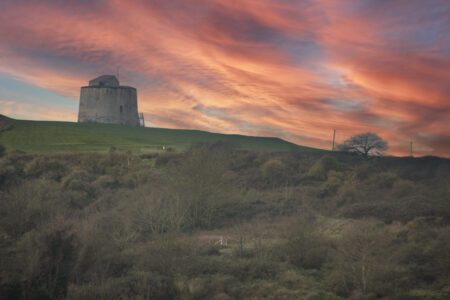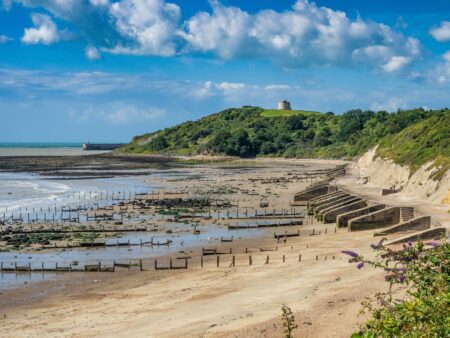ROMAN ROOTS
What have the Romans ever done for us? Well in Folkestone, Hythe and Romney Marsh the answer is really quite a lot!
The Romney Marsh and its main towns Folkestone and Hythe came about as the result of a great storm, the reclamation of land from the sea, the ongoing battle to drain the land and to stop the sea from reclaiming its own. Throughout the centuries, life on the Marsh involved sheep, smuggling, and defending England from invasion. Even earlier than that though, the Romans started to shape our county and culture.
I, CLAUDIUS
In AD43, Emperor Claudius landed a huge Roman army on the beaches in Kent, and the following year saw battle inland, storming through the local population and the victors setting up their own forts to protect themselves and remain vigilant against both the locals and potential invaders.
The remains of Stutfall Castle, built by the Romans to protect Port Lemanis (now called Port Lympne, and originally a Roman naval port) can still be seen in the fields overlooking the Marsh. As a sign of how important Stutfall Castle was, an altar inscribed to Neptune, God of the Seas, was erected by a prefect of the fleet in c. AD135/45.
Accessible by public footpath, the remains are remarkably well preserved, and offer spectacular views across the countryside and out to sea. While you’re in Lympne, you could take in a pie and a pint or a sandwich and a soft drink at The County Members. Warm, friendly and welcoming, it’s a proper English pub!

OF VILLAS AND VILLAGES
Perhaps many of us think of villas when the word Roman comes to mind, with classic examples to be found in the UK such as Fishbourne and Lullingstone.
But Folkestone actually had its own! Excavations have shown that the area has been populated from prehistoric times, and the existence of a villa on the East Cliff dating from the Roman era and discovered in 1924 reveals that people have been living here for over two millennia. Abandoned in around 400AD, the villa had over 50 rooms, some decorated with very fine mosaics.
Although the remains are no longer visible nor available to the public, a stroll along the East Cliffs can make you wonder how it would have felt to be crossing the cold Channel ready to invade and set up home here. Britain was such an important target that the recruits, from Italy, Spain and France, used a newly formed fleet, the Classis Britanicca.
The East Cliff and Warren Country Park is a fantastic spot to explore the area, with all the facilities from cafe to picnic spots, parking to toilets. Be warned though, it’s quite steep and not ideal for pushchairs or wheelchairs.
A quick trip into town from East Cliff (downhill all the way!) and you’ll be at Folkestone Museum, housed in the old Town Hall. The museum houses a fascinating collection of art, artefacts ancient and modern, and great activities to entrance minds young and old. From there, it’s a short stroll down the Harbour area where there is literally everything to choose from food and drink wise!


UPHILL FROM HYTHE
The pretty town of Hythe is a destination in itself, with a thriving High Street full of independent cafes, bars, restaurants, galleries and shops. Yet venture to Hythe Museum and you can find out more of the town’s history, from its earliest days. It’s rumoured that some of the bones in the ossuary at St Leonard’s Church are of Roman origin, due to the habit of clearing bodies from graveyards to make room for more – gruesome but practical, and because skulls and femurs tend to survive longest these are what have been saved to the ossuary.
After a little refreshment, you can walk along the Royal Military Canal – and if you look uphill you’ll see the remains of Stutfall Castle, bringing you full circle in our Roman reverie!